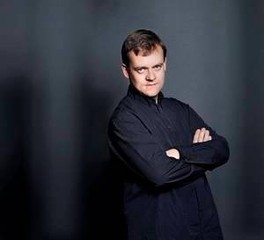|
Back
Gargantua Among the Lilliputions New York
David Geffen Hall, Lincoln Center
01/14/2016 - & January 15, 16, 2016
Ottorino Respighi: Vetrate di chiesa
Magnus Lindberg: Violin Concerto No. 2 (U.S. Premiere)
Igor Stravinsky: The Rite of Spring
Frank Peter Zimmermann (Violin)
New York Philharmonic Orchestra, Alan Gilbert (Conductor)

A. Gilbert, M. Lindberg (© Chris Lee)
“And Nicolai Rimsky-Korsakov, he of exotic climes and hues, did beget heirs Respighi and Stravinsky. And while Respighi glowed with illuminations like cloister parchments and towering pines, Stravinsky produced not only glorious flowerings but became eternal through spreading his seeds throughout the world, yea, even until Magnus Lindberg on the remote flat marshes of Finland.”
From The (Pretty Hot) Book of Numbers
It takes more than courage to have one’s newest music played on the same program with Stravinsky’s Rite of Spring. No matter what your genius, your inspiration, your great executor, you still have the metaphorical picture of Bob Hope’s genial pigmies against Rabelais’ Gargantua.
Not that this would ever stop Magnus Lindberg, whose orchestral creations are manifold, whose technical legerdemain is always on a balance with inspiration. And whose alliance with the New York Philharmonic these last years, as composer-in-residence and obvious love affair is constant.
Thus his Second Violin Concerto (New York Philharmonic Co-Commission with the London Philharmonic Orchestra, Berlin Philharmonic, and Swedish Radio Symphony Orchestra) was not only An Event, but it produced a full-house at David Geffen Hall. And well worth if for even the most conservative concertgoer. Mr. Lindberg is in that strange position of thinning out his orchestral complexities over the years, yet retaining a meatiness, and a plethora of splendid orchestral textures (with thanks, of course, to Igor Stravinsky). It still had so many ideas–ideas which were fluent, cohesive, interesting–that one would have to listen over and over again to begin to digest them all.

F. P. Zimmermann (© Courtesy of the Artist)
As he admitted in a pre-performance talk with conductor Alan Gilbert, Mr. Lindberg benefited enormously by working with its original player, Frank Peter Zimmermann, and this was shown through Mr. Zimmermann’s confident virtuosity throughout. Yes, he had a cadenza as the “second movement”, but from the very first really mysterious three notes, this was a great artist at work.
While the first solo notes, going up a minor second and a major second, each note augmented in sound, seemed mysterious, I realized by the following repetitions, that Mr. Zimmermann had been playing those rising tones with open fifths on the strings. Magnus Lindberg knows to make even the simplest musical cores mysteries in themselves.
Add to this the augmentations and developments throughout almost 30 minutes of music. Those three notes were played orchestral forces and the artist at different times, entering when least expected. Not interrupting the proceedings but seeming to survey the whole musical drama.
The difficulties must have been manifold, as Mr. Zimmermann didn’t simply play variations, but developed, capered with the orchestra, achieved duets with various players (including Concertmaster Frank Huang and manifold celesta and percussion players). Yet, Mr. Lindberg can never be faulted for his orchestral color or innately cohesive structure.
I say innately because, while I couldn’t put words to the construction, it seemed to all come together.
Harmonically, though, this Second Violin Concerto was a weird one. With a few notable exceptions, the piece could have been written by Jean Sibelius himself. At times, Mr. Zimmermann’s long lines with the orchestra had that kind of deep dark playing. The end, though, was a surprise. Whereas originally the fiddle was in the highest registers, suddenly, we had octave double-fingering (very Sibelius-like) and, for the first time, very soft measures to conclude.
To repeat, I would love to hear this again, not to “make sense” of it. The piece was emotionally gratifying. But because Magnus Lindberg has so much material. It is appetizing, tasty, but needs assimilation.
Mr. Gilbert’s entire program had that kind of color, starting with Respighi’s rarely-heard Church Windows. He is a dazzling composer–and his acolytes will enjoy three of his works with Charles Dutoit the first week of February. Church Windows takes much of the Respighi attraction in the second and fourth movements. A warrior Saint Michael and a bombastic Saint Gregory at the end.
But Respighi in lethargic moments sounds sluggish. At least this was the way the Phil started with The Flight Into Egypt. It still had the benefits of the composer’s unerring Rimsky-mentored orchestration–and a clarinet solo by Anthony McGill which had to be heard to be believed. And while I love all Respighi, I admit to looking forward to the Roman trilogy on February 3.
Onto the Avatar, Igor Stravinsky. Church Windows was written a decade after Sacre, Mr. Lindberg’s Concerto written a century later. Both sound old-fashioned.
The secret of Mr. Gilbert’s mastery came in a quote from the bassoon-player, Judith LeClair, that this is a ballet, the original orchestra was the orchestra pit. Still, now that the Phil was on stage, Mr. Gilbert decided to let the music speak for itself. The rhythms were angular, grotesque, balanced, the beat was rigid, the tempos were not plunging into fireworks, because the music doesn’t need such puttering around.
Mr. Gilbert above all knows that one need not tinker with perhaps the most influential single work in all of musical history.
Harry Rolnick
|